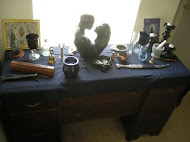
Amber is one of the stones associated with Lammas/Lughnassadh, so here is some info on it:
Amber, or fossil tree sap, was made famous in the movie "Jurassic Park". Amber is a beautiful stone that is cut and polished and used as a valuable gemstone. It is also a fossil and can contain many preserved insects and other animals and plants. Millions of years ago large stands of forests in some parts of the world began to seep globs of sticky resin. This aromatic resin oozed down the sides of trees, as well as filling internal fissures, trapping debris, such as seeds, leaves, feathers and insects. As geologic time progressed the forests were buried and the resin hardened into a soft, warm, golden gem, known as amber. The odd inclusions that are often seen in amber usually add to amber's unique look and in many cases greatly increase its value. The fossils that are encased in amber probably got there when they flew or crawled on to the fresh seeping sap and then got stuck. The sap oozed over the trapped animals and perhaps fell to the ground and was later covered by dirt and debris. The sap later hardened and became a fossil. Invaluable plant remains have been found in amber including flowers, mushroom caps, seeds, leaves, stems, pine needles and pine cones. Remember these are fossils and are not the same species that are alive today. Amber has greatly increased the knowledge of the evolution of insects and plants as well as enlivening the interest in paleontology in general.
Amber is not produced from tree sap, but rather from plant resin. Sap is the fluid that circulates through a plant's vascular system, while resin is the semi-solid amorphous organic substance secreted in pockets and canals through epithelial cells of the plant. This aromatic resin can drip from and ooze down trees, as well as fill internal fissures, trapping debris such as seeds, leaves, feathers and insects. The resin becomes buried and fossilized through a natural polymerization of the original organic compounds. Although a specific time interval has not been established for this process, the majority of amber is found within Cretaceous and Tertiary sedimentary rocks (approximately 30-90 million years old.) Although there are contrasting views as to why resin is produced, it is a plant's protection mechanism. The resin may be produced to protect the tree from disease and injury inflicted by insects and fungi. Resin may be exuded to heal a wound such as a broken branch, and resins possess odors or tastes that both attract and repel insects. In mature trees, resin may simply exude from vertical fissures in the bark due to tension produced by rapid growth. Resin may also be produced as a plant's method for disposing of excess acetate.
Amber is known to mineralogists as succinite, from the Latin succinum, which means amber. Heating amber will soften it and eventually it will burn, a fact that has given rise to the name of bernstein, by which the Germans know amber. Rubbing amber with a cloth will make it electric, attracting bits of paper. The Greek name for amber is elektron, or the origin of our word electricity. Amber is a poor conductor of heat and feels warm to the touch (minerals feel cool). Amber studies are truly interdisciplinary. Geologists and paleontologists are interested in amber because it is a fossil, evidence of prehistoric life. Archeologists look at trade routes and the barter view of amber. Organic chemists investigate the physical and chemical properties. Botanists and entomologists examine the botanical sources of amber and embalmed insects and debris. Poets, writers, and artists look to amber for sunny inspirations. Gemologists and jewelers desire amber for its beauty and rarity. Curators and conservationists preserve and archive amber. Technology has allowed for the extraction of DNA from animals and insects trapped in amber.
Most of these forests were situated in what is now the Baltic Sea area, although large deposits are also found in the Dominican Republic and China. As the Baltic Sea slowly encroached upon the pine forests, huge deposits of amber were submerged. Amber is thus often associated with the element of water, although for many it symbolizes fire. Dominican and Chinese amber is mined from deep underground deposits, giving it more of an association with earth. Amber is found in all Baltic countries; Venezuela; Russia; Romania; Burma; in coal seams in Wyoming, USA and the Dominican Republic. Color is amber yellow to orange.
Amber is found in a dazzling array of hues, and many of their names refer to food. The costly and rare "cherry" amber is a deep wine color, and derives it's colors from the sap of the now-extinct pine trees that they exuded from. These are found only in the Baltic, so most paleontologists theorize that these trees, with their deep green or deep red saps, were indigenous to this region. The enormous pine forest that once covered what is now the Baltic Sea is now completely submerged. "Custard," "butterscotch," "butter," "caramel," and "cream" ambers are self-descriptive. "Egg-yolk" amber actually looked like beaten eggs, with streaks of yellow and white. "Tomato" amber looks like partly ripe cherry tomatoes. The classic Baltic amber is usually called "honey" or "cognac," while the deeper, sunnier amber of the Dominican Republic is called "orange." An opaque type of Baltic amber is called "fatty" since it resembles a lump of animal fat, although this does not diminish its magical properties. Amber from Romania tends to be quite dark, as does Burmese, which is often called "tiger" amber because of its swirls of black in a dark orange. Amber also comes in a very rare blue, and black-and-white, as well as a lovely green. "Blonde" or "white" amber is often referred to as "new" amber by dealers. Although it is new only by a few million years!
While many people prefer amber in natural chunks, the process of slightly heating amber to make it malleable into round beads does not change its magical properties. Hand-faceted amber is very expensive, but molded faceted amber is affordable and genuine. However, "fused" or "reconstituted" amber is simply tiny chunks of amber fused together with a resin binder. Amber is often imitated by plastics, colored glasses and some modern tree resins. However, its hardness is usually greater and it is tougher than other resins. Amber can be burned, and is fluorescent under UV light and is much tougher (will not crumble as easily) than modern tree resins.
Amber is probably the oldest substance used for adornment, ritual and magical purposes. From ancient times, it was prized as "solidified sunlight," and believed to possess many of the sun's life-giving properties. As the fabled "gold of the North," it was much sought-after by the Greeks and Romans. Scott Cunningham notes that "amber has been used for nearly every purpose in magic." It was often worn by shamans and witches, who believed that it could increase the power of their magic. To this day, it is widely used around the world to safeguard health. Amber pendants were worn to preserve chastity, and used as rosary beads or talismans against evil and dark forces. Sailors burned amber on ships to drive away sea serpents and the perils of the deep. Amber was burned along with non-fossil tree resins, such as frankincense, myrrh, and copal to dispel evil spirits (and fumigate worldly nuisances such as mosquitos). Prussians and Samogitians used amber in the manufacture of incenses. In former times Lithuanian tribes employed such incense to drive away evil spirits from the dead and help the soul travel to good spirits. The newly born babies were fumigated so that they could grow faster, the newly-weds - that they could live happily and those going to war so that they could return with spoils of victory.
Before World War I amber was still used for treatment of various diseases, e.g. tincture made of pieces of amber and vodka was thought to increase sexual potency of men. In Lithuania and in tsarist Russia nannies had to wear amber beads to protect themselves and babies from diseases. As late as before World War II, especially in Germany, amber beads were put on babies to make the eruption of teeth less painful and make the teeth grow stronger. Even now in Lithuania many women suffering from goitre purchase curative amber beads made of unpolished pieces of amber to wear around the neck. It is a bio-stimulant that has a positive effect on the nervous system, the heart, and the kidneys and stimulates recovery processes. Honey was mixed with powdered amber and prescribed for asthma, gout, and the black plague. It was believed that amber protected one from madness, powder of amber mixed with honey cured throat, ear and eye diseases and taken with water cured stomach illnesses. It was also as a remedy for "swollen glands and sore throat and palate", and as a remedy for many diseases. There was a belief in eastern countries that amber smoke strengthens human spirit and gives courage. In China "amber syrup", a mixture of succinct acid and opium, was used as a tranquilizer and antispasmodic. In the Middle Ages amber beads were even worn for the treatment of jaundice. It was believed that the magic force of this yellow stone could absorb unhealthy yellowness of the skin and the weakness of the organism. Today amber is still used as a medicine!
Amber has a unique charm and air of mystery surrounding it. Amber may also possess magical properties now unknown to us: many Atlantologists believed that the fabled "aurichalcum" of Atlantis was actually molten amber. Its intensely magnetic and electrical properties (the Greek word elektron means amber) may indicate that it holds properties yet to be discovered. Anyone interested in amber is well advised to read Dr. Patty C. Rice's Amber: The Golden Gem of the Ages for an exhaustive and fascinating study.
Sources:
Disclaimer: No one involved in this blog or its contents may be held responsible for any adverse reactions arising from following any of the instructions/recipes on this list. It is the reader's personal responsibility to exercise all precautions and use his or her own discretion if following any instructions or advice from this blog.















No comments:
Post a Comment